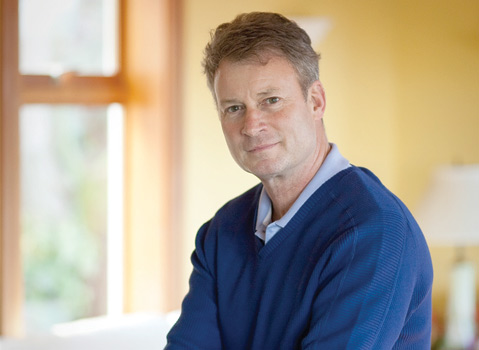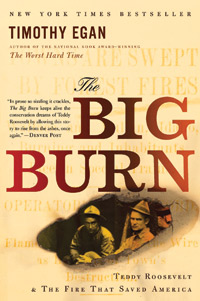Interview: Author Tim Egan
Pulitzer Prize-Winning Writer Comes to S.B. for UCSB Reads

Santa Barbarans know fire. Between 2007 and 2009, four significant blazes — Zaca, Gap, Tea, and Jesusita — blackened more than 260,000 acres of city and open space. As such, bestselling author Tim Egan’s book The Big Burn: Teddy Roosevelt and the Fire That Saved America was the perfect choice for this winter’s installment of UCSB Reads.
The Big Burn’s epicenter is the Great Fire of 1910, an inferno that scorched approximately 3 million acres of the U.S. North West — specifically Montana, Idaho, and Washington — in two days’ time. But Egan tells more than just the story of the conflagration. He also threads into the story relevant social and political circumstances of the era, a time when the National Forest Service formed, Teddy Roosevelt created the first public parks, the country struggled with massive immigration, and racism had a tight grip on the nation.
Recently, I spoke to Egan over the phone as he rode a train between tour stops, one of which will bring him to S.B. in the beginning of March.

What was the genesis for The Big Burn? I grew up in the city, in Seattle and my summers were in Idaho and Montana. There were always fires, big wildfires. They had a legendary, almost mythic stature among firefighters. I also grew up idolizing firefighters, yellow-shirted heroes who would jump into flame from a 40-foot steep slope. And then when I was older, when I started covering the West for The New York Times, I saw this story in another vein, which was sort of a creation myth of the U.S. Forest Service. I also saw how it had this domino effect on all future fires and our attitude toward fires, and so the two sort of came together.
I could see bits and pieces of the Big Burn [of 1910] when I was only a kid. I mean, we used to camp in the St. Joe’s river in Idaho, we camped in Montana, and we could see a few of the trees that were still scarred and standing, the spectral force left over from the [burn].
There are so many threads in the book. The amount of research you did is impressive. Thank you for saying that. I mean, when I started out, I was going to write a book about this amazing fire, just because of the size and ferocity of it. But the immigrant background, the founding of the [forestry] force [in 1905], the Buffalo Soldiers being there — it was pretty amazing. Then I got high-jacked by the amazing Teddy Roosevelt and his oddball but fascinating first forester, Gifford Pinchot. You know, it’s almost an accident of history; had McKinley not been assassinated and Roosevelt not been named president, we probably wouldn’t have the public land legacy in the United States that we have today.
So this one person, larger than life, had this huge effect on the way we live. That was so amazing. He and Pinchot would go skinny-dipping in the Potomac and go on these triathlon-like exercise routines in Oak Creek Park. They really relished the fight with the plutocrats of the day — sort of the one percent of their day — and they really got into taking those bastards on. And both of them were really emotionally damaged; Roosevelt had lost his wife and mother on the same day; Pinchot had lost his lover and lived with her ghost. All of that stuff came together to make me like the back story.
I was impressed with how you were able to cover so many topics and yet keep the story cohesive. Just the Italian immigrants could have been a story. That’s funny because I went to the little village on the French-Italian border in the Alps, where these guys were from, and there’s this cemetery plot that worships these young Italians who moved to the American West and gave it all up for the national forest system. I’m sort of an Italian-o-phile; I lived there for a while, so this gave me an excuse to go back there. But you’re right — they alone could have made a story. I got into the immigration side of it. I mean, a lot of it’s still relevant to today. But on the research side of it, it was just a combination of going to all these places, all these forests, and going to D.C. and reading all of Roosevelt’s stuff, all of his letters and diaries. He was the most prolific writer of any president and so he just has this huge bounty of written stuff he left behind.
How long did it take you to do this book? It usually takes me almost three years, which was the case for this book. Once I have the material, I’m a pretty quick writer; it takes me longer to get the stuff than to write it. I’m a pretty quick writer so when I get in the writing mode, I really crank it.
How did you winnow down all the information? That’s the tough thing. I had the same problem with the Dust Bowl book [2006’s The Worst Hard Time: The Untold Story of Those Who Survived the Great American Dust Bowl]. I interviewed probably 100 survivors, these last people left on the planet to really live through this worst environmental catastrophe, and I left 90-percent of those interviews on the cutting floor. In this case, I went to all these regional forester offices and read great personal reminiscences and I boiled it down to about five people. I wanted a woman in there, so I found that wonderful Pinky Adair, who’d left behind this great interview that stretched over three days, so I had her whole story.
And she outlived them all! She was alive until the 1970s, so I thought that was kind of a cool epilogue. So to answer your question, I was just looking for about four or five average people who could carry the story about the margins of history, and then there were the major figures: Pinchot, and Clark, the first senator from Montana, who was incredibly corrupt, and after whom Clark County, Nevada, is named. Those guys were kind of easy because they’re historical. The hard part is getting the characters in the margins.
It is like little memoirs of all these people in that way. Right. I don’t like to give away all my tricks, but that was what I was trying to do. I wanted these people at the margins to be alive as much as Roosevelt.
I was pulling for all them. When folks were looking for forester Joe Halm after the fires, for example. Yeah. He’s a great character! They write him off for dead; The New York Times writes his obit. Everyone was trying to find him. It was a really big deal, and then he stumbles out [of the woods].
How did you get involved with UCSB Reads? They came to me. I’m really flattered. … I mean, it’s an author’s dream to have an entire community reading your work and discussing the implications. I’m a huge believer that there’s no boring history, just boringly written history. It’s our story, it’s a shared story, it’s a dramatic one, and to have the whole community dive into it, I just couldn’t be more pleased.
I hadn’t heard of this book before, and it’s very pertinent to not only our fire community, but also the era that you wrote about. I found so many similarities, sadly, to our era. You wrote it a couple years ago, so I suppose you weren’t necessarily intending that? I wrote it on the theme of the 100th anniversary of the fire, so I wasn’t intending that at all. I was just interested in the story and I wanted to do it. But you’re right, the era, it was a great sort of echo of history. One was the division between the rich and poor; it was the biggest gap until today. A second thing was it was the biggest period of immigration in our history, mostly from the southern European places. People weren’t necessarily well accepted, mainly the dark-skinned southern Italians and Greeks. So it was a great sort of echo of what’s going on now. I liked that part of it.
It’s like all the stars aligned for you with this book. Right. And then Pinchot made these prophetic statements, and being a great character himself, and how the Forest Service changed and how our feelings towards nature changed —the hubristic attitude and that sort of thing.
Senator Clark is mentioned a lot in the book, too. He has a big connection here in Santa Barbara because Huguette Clark. You know the story, don’t you?
Yes. I read Bill Dedman’s book Empty Mansions. Oh, great.
She was an odd character, as was her father, so I found the parts about Senator Clark interesting. I thought that was utterly fascinating. I got a lot of calls from people, asking if this woman was [Clark’s] daughter. Clark spent his entire term as a Montana senator living in one of the biggest mansions in Manhattan. He [felt] that the future generations can take care of themselves.
At times it was hard to read, when you describe the animals and the men burning. Yeah, there were a lot of horrible descriptions of trees falling and burying people, animals getting suffocated, really horrific stuff. I mean, if you’re going to write about a fire, you can’t gloss it over, you have to make people feel what it was like.
You definitely did that, definitely brought it to life. So what are you going to talk about when you come to Santa Barbara? I’m going to talk about some of what you brought up, the echoes of then to now, how the years were similar, what we learned and didn’t learn from that fire. We learned some things, but now we try to put out every fire, and one of the reasons we have such massive fires now is because the fuel has built up, because they didn’t let the fire become a part of nature, which it is. And now they’re trying to manage it, to reach a more central ground on that… the past is just not that far from present days.
One more thing I want people to appreciate is not just the magnitude of the fire, but what we have in our public land and how unique it is — it’s one of those things that makes the United States stand out. I lived in Europe and public lands are anomalous. It’s a big deal, living in the West, and that there is an area almost the size of Germany that each one of us own. That’s largely because of [Teddy Roosevelt], so I always want to praise him for that.
411:
Tim Egan will deliver a free talk on The Big Burn at UCSB’s Campbell Hall on Tuesday, March 4 at 8 p.m. For info, call (805) 893-3535 or visit artsandlectures.sa.ucsb.edu.



